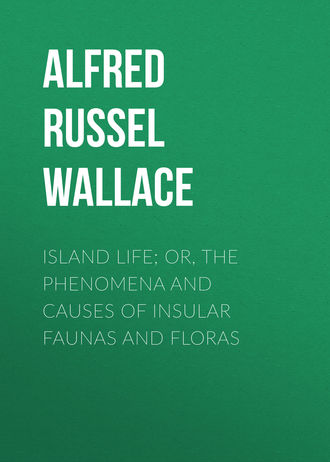 полная версия
полная версияIsland Life; Or, The Phenomena and Causes of Insular Faunas and Floras
The quantity of heat required to melt ice or snow is very great, as we all know by experience of the long time masses of snow will remain unmelted even in warm weather. We shall however be better able to appreciate the great effect this has upon climate, by a few figures showing what this amount really is. In order to melt one cubic foot of ice, as much heat is required as would heat a cubic foot of water from the freezing point to 176° F., or two cubic feet to 88° F. To melt a layer of ice a foot thick will therefore use up as much heat as would raise a layer of ice-cold water two feet thick to the temperature of 88° F.; and the effect becomes still more easily understood if we estimate it as applied to air, for to melt a layer of ice only 1½ inches thick would require as much heat as would raise a stratum of air 800 feet thick from the freezing point to the tropical heat of 88° F.! We thus obtain a good idea, both of the wonderful power of snow and ice in keeping down temperature, and also of the reason why it requires so long a time to melt away, and is able to go on accumulating to such an extent as to become permanent. These properties would, however, be of no avail if it were liquid, like water; hence it is the state of solidity and almost complete immobility of ice that enables it to produce by its accumulation such extraordinary effects in physical geography and in climate, as we see in the glaciers of Switzerland and the ice-capped interior of Greenland.
High Land and great Moisture Essential to the Initiation of a Glacial Epoch.—Another point of great importance in connection with this subject, is the fact, that this permanent storing up of cold depends entirely on the annual amount of snow-fall in proportion to that of the sun and air-heat, and not on the actual cold of winter, or even on the average cold of the year.46 A place may be intensely cold in winter and may have a short arctic summer, yet, if so little snow falls that it is quickly melted by the returning sun, there is nothing to prevent the summer being hot and the earth producing a luxuriant vegetation. As an example of this we have great forests in the extreme north of Asia and America where the winters are colder and the summers shorter than in Greenland in Lat. 62° N., or than in Heard Island and South Georgia, both in Lat. 53° S. in the Southern Ocean, and almost wholly covered with perpetual snow and ice. At the "Jardin" on the Mount Blanc range, above the line of perpetual snow, a thermometer in an exposed situation marked -6° F. as the lowest winter temperature: while in many parts of Siberia mercury freezes during several weeks in winter, showing a temperature below -40° F.; yet here the summers are hot, all the snow disappears, and there is a luxuriant vegetation. Even in the very highest latitudes reached by our last Arctic Expedition there is very little perpetual snow or ice, for Captain Nares tells us that north of Haye's Sound, in Lat. 79° N., the mountains were remarkably free from ice-cap, while extensive tracts of land were free from snow during summer, and covered with a rich vegetation with abundance of bright flowers. The reason of this is evidently the scanty snow-fall, which rendered it sometimes difficult to obtain enough to form shelter-banks around the ships; and this was north of 80° N. Lat., where the sun was absent for 142 days.
Perpetual Snow Nowhere Exists on Lowland Areas.—It is a very remarkable and most suggestive fact, that nowhere in the world at the present time are there any extensive lowlands covered with perpetual snow. The Tundras of Siberia and the barren grounds of N. America are all clothed with some kind of summer vegetation;47 and it is only where there are lofty mountains or plateaus—as in Greenland, Spitzbergen, and Grinnell's Land—that glaciers, accompanied by perpetual snow, cover the country, and descend in places to the level of the sea. In the Antarctic regions there are extensive highlands and lofty mountains, and these are everywhere exposed to the influence of moist sea-air; and it is here, accordingly, that we find the nearest approach to a true ice-cap covering the whole circumference of the Antarctic continent, and forming a girdle of ice-cliffs which almost everywhere descend to the sea. Such Antarctic islands as South Georgia, South Shetland, and Heard Island, are often said to have perpetual snow at sea-level; but they are all very mountainous, and send down glaciers into the sea, and as they are exposed to moist sea-air on every side, the precipitation, almost all of which takes the form of snow even in summer, is of course unusually large.48
That high land in an area of great precipitation is the necessary condition of glaciation, is well shown by the general state of the two polar areas at the present time. The northern part of the north temperate zone is almost all land, mostly low but with elevated borders; while the polar area is, with the exception of Greenland and a few other considerable islands, almost all water. In the southern hemisphere the temperate zone is almost all water, while the polar area is almost all land, or is at least inclosed by a ring of high and mountainous land. The result is that in the north the polar area is free from any accumulation of permanent ice (except on the highlands of Greenland and Grinnell's Land), while in the south a complete barrier of ice of enormous thickness appears to surround the pole. Dr. Croll shows, from the measured height of numerous Antarctic icebergs (often miles in length) that the ice-sheet from which they are the broken outer fragments must be from a mile to a mile and a half in thickness.49 As this is the thickness of the outer edge of the ice it must be far thicker inland; and we thus find that the Antarctic continent is at this very time suffering glaciation to quite as great an extent as we have reason to believe occurred in the same latitudes of the northern hemisphere during the last glacial epoch.
The accompanying diagrams show the comparative state of the two polar areas both as regards the distribution of land and sea, and the extent of the ice-sheet and floating icebergs. The much greater quantity of ice at the south pole is undoubtedly due to the presence of a large extent of high land, which acts as a condenser, and an unbroken surrounding ocean, which affords a constant supply of vapour; and the effect is intensified by winter being there in aphelion, and thus several days longer than with us, while the whole southern hemisphere is at that time farther from the sun, and therefore receives less heat.
We see, however, that with less favourable conditions for the production and accumulation of ice, Greenland is glaciated down to Lat. 61°. What, then, would be the effect if the Antarctic continent, instead of being confined almost wholly within the south polar circle, were to extend in one or two great mountainous promontories far into the temperate zone? The comparatively small Heard Island in S. Lat. 53° is even now glaciated down to the sea. What would be its condition were it a northerly extension of a lofty Antarctic continent? We may be quite sure that glaciation would then be far more severe, and that an ice-sheet corresponding to that of Greenland might extend to beyond the parallel of 50° S. Lat. Even this is probably much too low an estimate, for on the west coast of New Zealand in S. Lat. 43° 35′ a glacier even now descends to within 705 feet of the sea-level; and if those islands were the northern extension of an Antarctic continent, we may be pretty sure that they would be nearly in the ice-covered condition of Greenland, although situated in the latitude of Marseilles.

Diagram of the approximate extent of Permanent and Floating Ice around the North and the South Poles. (After Petermann.)
Conditions Determining the Presence or Absence of Perpetual Snow.—It is clear, then, that the vicinity of a sea or ocean to supply moisture, together with high land to serve as a condenser of that moisture into snow, are the prime essentials of a great accumulation of ice; and it is fully in accordance with this view that we find the most undoubted signs of extensive glaciation in the west of Europe and the east of North America, both washed by the Atlantic and both having abundance of high land to condense the moisture which it supplies. Without these conditions cold alone, however great, can produce no glacial epoch. This is strikingly shown by the fact, that in the very coldest portions of the two northern continents—Eastern Siberia and the north-western shores of Hudson's Bay—there is no perennial covering of snow or ice whatever. No less remarkable is the coincidence of the districts of greatest glaciation with those of greatest rainfall at the present time. Looking at a rain-map of the British Isles, we see that the greatest area of excessive rainfall is the Highlands of Scotland, then follows the west of Ireland, Wales, and the north of England; and these were glaciated pretty nearly in proportion to the area of country over which there is an abundant supply of moisture. So in Europe, the Alps and the Scandinavian mountains have excessive rainfall, and have been areas of excessive glaciation, while the Ural and Caucasian mountains, with less rain, never seem to have been proportionally glaciated. In North America the eastern coast has an abundant rainfall, and New England with North-eastern Canada seems to have been the source of much of the glaciation of that continent.50
The reason why no accumulation of snow or ice ever takes place on Arctic lowlands is explained by the observations of Lieut. Payer of the Austrian Polar Expedition, who found that during the short Arctic summer of the highest latitudes the ice-fields diminished four feet in thickness under the influence of the sun and wind. To replace this would require a precipitation of snow equivalent to about 45 inches of rain, an amount which rarely occurs in lowlands out of the tropics. In Siberia, within and near the Arctic circle, about six feet of snow covers the country all the winter and spring, and is not sensibly diminished by the powerful sun so long as northerly winds keep the air below the freezing-point and occasional snow-storms occur. But early in June the wind usually changes to southerly, probably the south-western anti-trades overcoming the northern inflow; and under its influence the snow all disappears in a few days and the vegetable kingdom bursts into full luxuriance. This is very important as showing the impotence of mere sun-heat to get rid of a thick mass of snow so long as the air remains cold, while currents of warm air are in the highest degree effective. If, however, they are not of sufficiently high temperature or do not last long enough to melt the snow, they are likely to increase it, from the quantity of moisture they bring with them which will be condensed into snow by coming into contact with the frozen surface. We may therefore expect the transition from perpetual snow to a luxuriant arctic vegetation to be very abrupt, depending as it must on a few degrees more or less in the summer temperature of the air; and this is quite in accordance with the fact of corn ripening by the sides of alpine glaciers.
Efficiency of Astronomical Causes in Producing Glaciation.—Having now collected a sufficient body of facts, let us endeavour to ascertain what would be the state to which the northern hemisphere would be reduced by a high degree of excentricity and a winter in aphelion. When the glacial epoch is supposed to have been at its maximum, about 210,000 years ago, the excentricity was more than three times as great as it is now, and, according to Dr. Croll's calculations, the mid-winter temperature of the northern hemisphere would have been lowered 36° F., while the winter half of the year would have been twenty-six days longer than the summer half. This would bring the January mean temperature of England and Scotland almost down to zero or about 30° F. of frost, a winter climate corresponding to that of Labrador, or the coast of Greenland on the Arctic circle. But we must remember that the summer would be very much hotter than it is now, and the problem to be solved is, whether, supposing the geography of the northern hemisphere to have been identical with what it is now, the snow that fell in winter would accumulate to such an extent that it would not be melted in summer, and so go on increasing year by year till it covered the whole of Scotland, Ireland, and Wales, and much of England. Dr. Croll and Dr. Geikie answer that it would. Sir Charles Lyell maintained that it would only do so if geographical conditions were then more favourable than they are now; while the late Mr. Belt has argued, that excentricity alone would not produce the effect unless aided by increased obliquity of the ecliptic, which, by extending the width of the polar regions, would increase the duration and severity of the winter to such an extent that snow and ice would be formed in the Arctic and Antarctic regions at the same time whether the winter were in perihelion or aphelion.51
The problem we have now to solve is a very difficult one, because we have no case at all parallel to it from which we can draw direct conclusions. It is, however, clear from the various considerations we have already adduced, that the increased cold of winter when the excentricity was great and the sun in aphelion during that season, would not of itself produce a glacial epoch unless the amount of vapour supplied for condensation was also exceptionally great. The greatest quantity of snow falls in the Arctic regions in summer and autumn, and with us the greatest quantity of rain falls in the autumnal months. It seems probable, then, that in all northern lands glaciation would commence when autumn occurred in aphelion. All the rain which falls on our mountains at that season would then fall as snow, and, being further increased by the snow of winter, would form accumulations which the summer might not be able to melt. As time went on, and the aphelion occurred in winter, the perennial snow on the mountains would have accumulated to such an extent as to chill the spring and summer vapours, so that they too would fall as snow, and thus increase the amount of deposition; but it is probable that this would never in our latitudes have been sufficient to produce glaciation, were it not for a series of climatal reactions which tend still further to increase the production of snow.
Action of Meteorological Causes in intensifying Glaciation.—The trade-winds owe their existence to the great difference between the temperature of the equator and the poles, which causes a constant flow of air towards the equator. The strength of this flow depends on the difference of temperature and the extent of the cooled and heated masses of air, and this effect is now greatest between the south pole and the equator, owing to the much greater accumulation of ice in the Antarctic regions. The consequence is, that the south-east trades are stronger than the north-east, the neutral zone or belt of calms between them not being on the equator but several degrees to the north of it. But just in proportion to the strength of the trade-winds is the strength of the anti-trades, that is, the upper return current which carries the warm moisture-laden air of the tropics towards the poles, descending in the temperate zone as west and south-west winds. These are now strongest in the southern hemisphere, and, passing everywhere over a wide ocean, they supply the moisture necessary to produce the enormous quantity of snow which falls in the Antarctic area. During the period we are now discussing, however, this state of things would have been partially reversed. The south polar area, having its winter in perihelion, would probably have had less ice, while the north-temperate and Arctic regions would have been largely ice-clad; and the north-east trades would therefore be stronger than they are now. The south-westerly anti-trades would also be stronger in the same proportion, and would bring with them a greatly increased quantity of moisture, which is the prime necessity to produce a condition of glaciation.
But this is only one-half of the effect that would be produced, for the increased force of the trades sets up another action which still further helps on the accumulation of snow and ice. It is now generally admitted that we owe much of our mild climate and our comparative freedom from snow to the influence of the Gulf Stream, which also ameliorates the climate of Scandinavia and Spitzbergen, as shown by the remarkable northward curvature of the isothermal lines, so that Drontheim in N. Lat. 62° has the same mean temperature as Halifax (Nova Scotia) in N. Lat. 45°. The quantity of heat now brought into the North Atlantic by the Gulf Stream depends mainly on the superior strength of the south-east trades. When the north-east trades were the more powerful, the Gulf Stream would certainly be of much less magnitude and velocity; while it is possible, as Dr. Croll thinks, that a large portion of it might be diverted southward owing to the peculiar form of the east coast of South America, and so go to swell the Brazilian current and ameliorate the climate of the southern hemisphere.
That effects of this nature would follow from any increase of the Arctic, and decrease of the Antarctic ice, may be considered certain; and Dr. Croll has clearly shown that in this case cause and effect act and react on each other in a remarkable way. The increase of snow and ice in the northern hemisphere is the cause of an increased supply of moisture being brought by the more powerful anti-trades, and this greater supply of moisture leads to an extension of the ice, which reacts in still further increasing the supply of moisture. The same increase of snow and ice, by causing the north-east to be stronger than the south-east trade-winds, diminishes the force of the Gulf Stream, and this diminution lowers the temperature of the North Atlantic both in summer and winter, and thus helps on still further the formation and perpetuation of the icy mantle. It must also be remembered that these agencies are at the same time acting in a reverse way in the southern hemisphere, diminishing the supply of the moisture carried by the anti-trades, and increasing the temperature by means of more powerful southward ocean-currents;—and all this again reacts on the northern hemisphere, increasing yet further the supply of moisture by the more powerful south-westerly winds, while still further lowering the temperature by the southward diversion of the Gulf Stream.
Summary of Principal Causes of Glaciation.—I have now sufficiently answered the question, why the short hot summer would not melt the snow which accumulated during the long cold winter (produced by high excentricity and winter in aphelion), although the annual amount of heat received from the sun was exactly the same as it is now, and equal in the two hemispheres. It may be well, before going further, briefly to summarise the essential causes of this apparent paradox. These are—primarily, the fact that solar heat cannot be stored up owing to its being continually carried away by air and water, while cold can be so stored up owing to the comparative immobility of snow and ice; and, in the second place, because the two great heat-distributing agencies, the winds and the ocean-currents, are so affected by an increase of the snow and ice towards one pole and its diminution towards the other, as to help on the process when it has once begun, and by their action and reaction produce a maximum of effect which, without their aid, would be altogether unattainable.
But even this does not exhaust the causes at work, all tending in one direction. Snow and ice reflect heat to a much greater degree than do land or water. The heat, therefore, of the short summer would have far less effect than is due to its calculated amount in melting the snow, because so much of it would be lost by reflection. A portion of the reflected heat would no doubt warm the vapour in the atmosphere, but this heat would be carried off to other parts of the earth, while a considerable portion of the whole would be lost in space. It must also be remembered that an enormous quantity of heat is used up in melting snow and ice, without raising its temperature; each cubic foot of ice requiring as much heat to melt it as would raise nearly six cubic feet of water 30° F. It has, however, been argued that because when water is frozen it evolves just as much heat as it requires to melt it again, there is no loss of heat on the whole; and as this is adduced over and over again as a valid argument in every criticism of Dr. Croll's theory, it may be well to consider it a little more closely. In the act of freezing no doubt water gives up some of its heat to the surrounding air; but that air still remains below the freezing point or freezing would not take place. The heat liberated by freezing is, therefore, what may be termed low-grade heat—heat incapable of melting snow or ice; while the heat absorbed while ice or snow is melting is high-grade heat, such as is capable of melting snow and supporting vegetable growth. Moreover, the low-grade heat liberated in the formation of snow is usually liberated high up in the atmosphere, where it may be carried off by winds to more southern latitudes, while the heat absorbed in melting the surface of snow and ice is absorbed close to the earth and is thus prevented from warming the lower atmosphere, which is in contact with vegetation. The two phenomena, therefore, by no means counterbalance or counteract each other, as it is so constantly and superficially asserted that they do.
Effect of Clouds and Fog in cutting off the Sun's Heat.—Another very important cause of diminution of heat during summer in a glaciated country would be the intervention of clouds and fogs, which would reflect or absorb a large proportion of the sun-heat and prevent it reaching the surface of the earth; and such a cloudy atmosphere would be a necessary result of large areas of high land covered with snow and ice. That such a prevalence of fogs and cloud is an actual fact in all ice-clad countries has been shown by Dr. Croll most conclusively, and he has further shown that the existence of perpetual snow often depends upon it. South Georgia in the latitude of Yorkshire is almost, and Sandwich Land in the latitude of the north of Scotland, is entirely covered with perpetual snow; yet in their summer the sun is three million miles nearer the earth than it is in our summer, and the heat actually received from the sun must be sufficient to raise the temperature 20° F. higher than in the same latitudes in the northern hemisphere, were the conditions equal—instead of which their summer temperature is probably full 20° lower. The chief cause of this can only be that the heat of the sun does not reach the surface of the earth; and that this is the fact is testified by all Antarctic voyagers. Darwin notes the cloudy sky and constant moisture of the southern part of Chile, and in his remarks on the climate and productions of the Antarctic islands he says: "In the Southern Ocean the winter is not so excessively cold, but the summer is far less hot (than in the north), for the clouded sky seldom allows the sun to warm the ocean, itself a bad absorbent of heat; and hence the mean temperature of the year, which regulates the zone of perpetually congealed under-soil, is low." Sir James Ross, Lieutenant Wilkes, and other Antarctic voyagers speak of the snow-storms, the absence of sunshine, and the freezing temperature in the height of summer; and Dr. Croll shows that this is a constant phenomenon accompanying the presence of large masses of ice in every part of the world.52
In reply to the objections of a recent critic Dr. Croll has given a new proof of this important fact by comparing the known amount of snow-fall with the equally well-known melting power of direct sun-heat in different latitudes. He says: "The annual precipitation on Greenland in the form of snow and rain, according to Dr. Rink, amounts to only twelve inches, and two inches of this he considers is never melted, but is carried away in the form of icebergs. The quantity of heat received at the equator from sunrise to sunset, if none were cut off by the atmosphere, would melt 3⅓ inches of ice, or 100 feet in a year. The quantity received between latitude 60° and 80°, which is that of Greenland, is, according to Meech, one-half that received at the equator. The heat received by Greenland from the sun, if none were cut off by the atmosphere, would therefore melt fifty feet of ice per annum, or fifty times the amount of snow which falls on that continent. What then cuts off the ninety-eight per cent of the sun's heat?" The only possible answer is, that it is the clouds and fog during a great part of the summer, and reflection from the surface of the snow and ice when these are absent.









